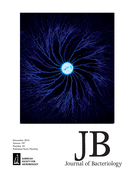 Researchers in Germany have retracted their 2011 article in the Journal of Bacteriology after another lab pointed out a fatal error in the paper.
Researchers in Germany have retracted their 2011 article in the Journal of Bacteriology after another lab pointed out a fatal error in the paper.
The article, “Escherichia coli Exports Cyclic AMP via TolC,” came from a group at Tübingen University led by Klaus Hantke. The paper focuses on the crucial role of the membrane channel TolC in exporting cyclic AMP (cAMP)-cAMP receptor protein (CRP) complex, which regulates nearly 200 E. coli genes. According to the abstract:
The data demonstrate that export of cAMP via TolC is a most efficient way of E. coli to lower high concentrations of cAMP in the cell and maintain its sensitivity in changing metabolic environments.
But the conclusions rested on a gene mutation that wasn’t quite what it seemed. Here’s the notice:
We were informed by Kevin Young and Gang Li (Microbiology 160:2079–2088, 2014) that strain H41 is not a tolC mutant as we had described. We have sequenced strain H41 and confirm that it is not a tolC mutant. Rather, the observed phenotype is due to a point mutation in crp and the subsequent A144T substitution in the Crp protein that reduces the requirement for cyclic AMP. Since the conclusions of our paper are based on the presumed tolC mutation, they are no longer valid and we regretfully retract the manuscript. Klaus Hantke assumes full responsibility for this error.
Hantke told us:
Now I know that I should have checked the strain I used a bit more carefully. I thought, I picked this strain after a P1 transduction of tolC::Tn10 — at which step during the isolation procedure I picked this strain I can not reconstruct. The properties of these crp* mutants have been described — however, it was not explicitly stated that they are supersensitive to cAMP. For instance the mal system can be induced with much lower cAMP concentrations in a Crp* mutant than in the Crp+ strain.
I must confess that I did not know of the existence of Crp* mutants before I got the sequence of my strain and checked the literature. We now use this mutant to study low activity changes in cloned adenylyl cyclases.
We spoke with Young, who’s at the University of Arkansas in Little Rock. He told us his group was working on something “completely different” when they found Hantke’s study and wanted to look further at it. (“In fact,” he told us “my goal is never to work on cyclic AMP. It’s just a mess, with a huge literature.”)
We requested their strain because we wanted to move the mutation in and make sure it was doing the same thing. We spent three months, and finally said, ‘To heck with this.’ So we sequenced it and found that it wasn’t the mutation [that the researchers had reported].
Young says he and his colleagues notified Hantke et al in 2013 about the problem.
We sent a letter back to them saying we’ve checked, this is not the mutation — either they didn’t send the correct strain, or the strain itself is incorrect.
Young is philosophical about the error, which he said
has the benefit of moving everything forward. Things happen; things have happened in our lab.
As for why the process took so long, well:
An elephant turns slowly.
We commend everyone involved here for this example of how science should work.
Like Retraction Watch? Consider making a tax-deductible contribution to support our growth. You can also follow us on Twitter, like us on Facebook, add us to your RSS reader, and sign up on our homepage for an email every time there’s a new post. Click here to review our Comments Policy.